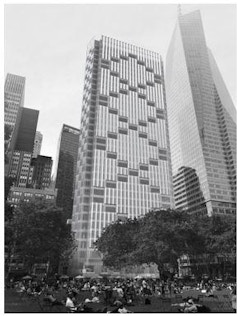
26 results
-
 The building envelope is at the intersection of embodied and operational emissions. Curtain wall specifically could play an important role in…
The building envelope is at the intersection of embodied and operational emissions. Curtain wall specifically could play an important role in… -
Facade Embodied Carbon Reduction Strategies
- Paper by Isabelle Hens, LEED AP BD+C, WELL AP, Senior Environmental Designer
Facades are increasingly being recognized as a major contributor to whole-building embodied carbon. While designers know how to reduce the embodied… -

Addressing Embodied Carbon
- Paper by Helen Sanders, PhD · Adam Nizich
Reducing greenhouse gas emissions from the building sector is critical to limiting global temperature rise to less than 1.5⁰C. Construction and
-

Façade Systems and Embodied Carbon
- Paper by Paulina Szpiech · Valerie Leon-Green · Shivanie Rambaran
Life Cycle Assessment (LCA) is a methodology used to quantify the impact of building construction supply chains on the environment in terms of
-
Glass in GSA Buildings
- Paper by Georgia Scalfano, Technical Services Sustainability Manager
Embodied carbon in buildings is a key factor in building decarbonization and while it is generally small compared to operational carbon, the… -

Pioneering the Structural Terracotta Mullion Façade
- Paper by Victoria Ereskina · John Neary
Architects today must explore alternative enclosure materials to meet evolving energy codes and embodied carbon regulations. Terra cotta has been
-

Low-Carbon Cladding and Shading Design
- Paper by Prateek Jain, LEED · Isabelle Hens, LEED GA, WELL AP, EIT
In the last few years, the design community has embraced the challenge of reducing embodied carbon in buildings. Several tools are now available for
-

The Carbon Footprint of Aluminum Fenestration
- Paper by Tom Bougher · Richard Braunstein
The historical focus on reducing the carbon footprint of a building has recently shifted to include more emphasis on embodied carbon, the carbon
-

Towards Net Zero Enclosures
- Paper by Jessica Santonastaso, AIA · Alan Estabrook, AIA
As architects and designers we understand the urgency of addressing the building sector’s role in the ongoing environmental crisis. Architecture2030
-
Contextualizing Glass and Carbon Impacts
- Paper by Kayla Natividad, PhD, WELL AP, LEED Green Associate, Architectural Technical Service Engineer Kyle Sword, Manager Business Development
Climate change goals will require significant improvements in the way buildings are constructed and operated. Building reuse can combat climate… -

Prefab Facades – from Prototype to Product?
- Paper by Lisa Rammig, Andrea Zani, Tim Murphy,
Building envelopes are not only an immediately visible part of the building, they have also become a major factor both for cost and performance of… -

End-of-Life Challenges in Facade Design
- Paper by Rebecca Hartwell, PhD Candidate Mauro Overend, Professor of Structural Design & Mechanics
In recent decades, there has been increased attention to reduce the operational energy performance of buildings. Stringent legislation on building… -

Bringing an Icon Into the Future: Willis Tower
- Paper by Stephen Katz
Few buildings are as iconic as Willis Tower. Generations of Chicagoans have a collective memory of this building playing a role in their entire
-
Sustainable Façades
- Paper by Dr. Thomas Henriksen · Jean-Marc Moulin Norsk · Dr. Jacopo Montali
Transposing innovation from government funded research to commercially viable solutions becomes ever more important when combined with the urgent
-

Innovative Façades for a Sustainable Architecture
- Paper by Lucio Blandini
Facades play a relevant role in the search for a more sustainable approach to modern architecture. The amount of embodied and operational energy can
-
Mapping Advanced Facades
- Paper by David Russell Lehrer, CBE's Communications Director Vito Lamberti, Visiting Ph.D. Student
This paper describes the development of an interactive map that highlights case studies of advanced facade design strategies and technologies from… -

Fire Safety and Code Challenges for Mass Timber in Curtain Wall Systems
- Paper by David Barber, Principal John Neary, Senior Associate, Senior Facade Specialist Mic Patterson PhD LEED AP+, Ambassador of Innovation & Collaboration
With the desire for more sustainable construction and reduced embodied energy, mass timber is being explored for building structures. For medium and… -
Evaluating The Environmental Performance Of Stick Curtain Wall Systems
- Paper by Dima Othman · Daniel Arztmann
The construction industry is one of the greatest sources of pollution, where 39% of global energy-related carbon emissions are attributed to
-
Carbon-Neutral High-Rise Envelope Nexus
- Paper by Thomas Spiegelhalter, Principal
The pathway to carbon-neutrality, as urged during the COP 21 in Paris, and the repeated goal for resilient buildings and urban habitats, winds right… -
Structuring Skin
- Paper by John Neary
Curtain wall is the prevailing type of enclosure on modern buildings because of its economy, its independence from structure that allows flexibility
